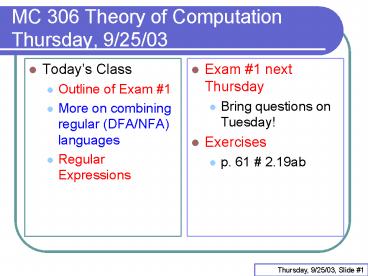MC 306 Theory of Computation Thursday, 92503 - PowerPoint PPT Presentation
1 / 6
Title:
MC 306 Theory of Computation Thursday, 92503
Description:
More on combining regular (DFA/NFA) languages. Regular Expressions. Exam #1 next Thursday ... converting NFAs to DFAs, combining regular languages, regular ... – PowerPoint PPT presentation
Number of Views:43
Avg rating:3.0/5.0
Title: MC 306 Theory of Computation Thursday, 92503
1
MC 306 Theory of ComputationThursday, 9/25/03
- Todays Class
- Outline of Exam 1
- More on combining regular (DFA/NFA) languages
- Regular Expressions
- Exam 1 next Thursday
- Bring questions on Tuesday!
- Exercises
- p. 61 2.19ab
2
Exam 1 Outline
- Material Exam 1 covers all material through
todays class - Chapter 1, Math Preliminaries Material covered
in class and assignments (sets, relations,
equivalence relations) - Chapter 2, Finite Automata 2.1-2.4 DFAs, NFAs,
converting NFAs to DFAs, combining regular
languages, regular expressions, equivalence of FA
and regular expression languages, converting
regular expressions to NFAs, e - Kinds of questions Stating definitions and
theorems carefully, giving examples and
counterexamples, doing problems similar to class
examples, exercises, and hand-in problems - Reference Sheet You may bring one 8½ x 11
sheet with any notes you wish to write on it.
3
Regular Expressions versus DFAs/NFas
- Every DFA/NFA M determines a language L(M)
- Every regular expression r determines a language
L(r) - Theorem. The set of DFA/NFA languages exactly
equals the set of regular expression languages. - Hence we call these languages regular, which can
be interpreted either way by this theorem
4
Proving Equivalence of DFA and regular expression
languages.
- An If and Only If Theorem is really 2 theorems
- Theorem 1 If L L(r) is a language
corresponding to a regular expression r, then
there is a DFA/NFA Mr that accepts L, i.e., L
L(Mr) - Proof plan Start with a regular expression r
that corresponds to L. Show how to use r to
design a DFA/NFA that accepts L. - Theorem 2 If L L(M) is a language
corresponding to a DFA/NFA M, then there is a
regular expression rM corresponding to L, i.e., L
L(rM). - Proof plan Start with a DFA/NFA M that accepts
L. Show how to use M to design a regular
expression that corresponds to L.
5
Theorem 1 Convert from regular expression to NFA
- Since definition of regular expression is
inductive, we do a base case, and then an
inductive case (work done on board). - Base case If the regular expression is a single
symbol ?, ?, x?? - Inductive case If r1 and r2 are regular
expressions that weve built NFAs for, how do we
build an NFA for (r1 ? r2), (r1r2), and r1?
6
Example
- Find an NFA that accepts the language described
by the regular expression - (a ? b) aa
- Note Well prove other half of Theorem, and do
an example, next time.































